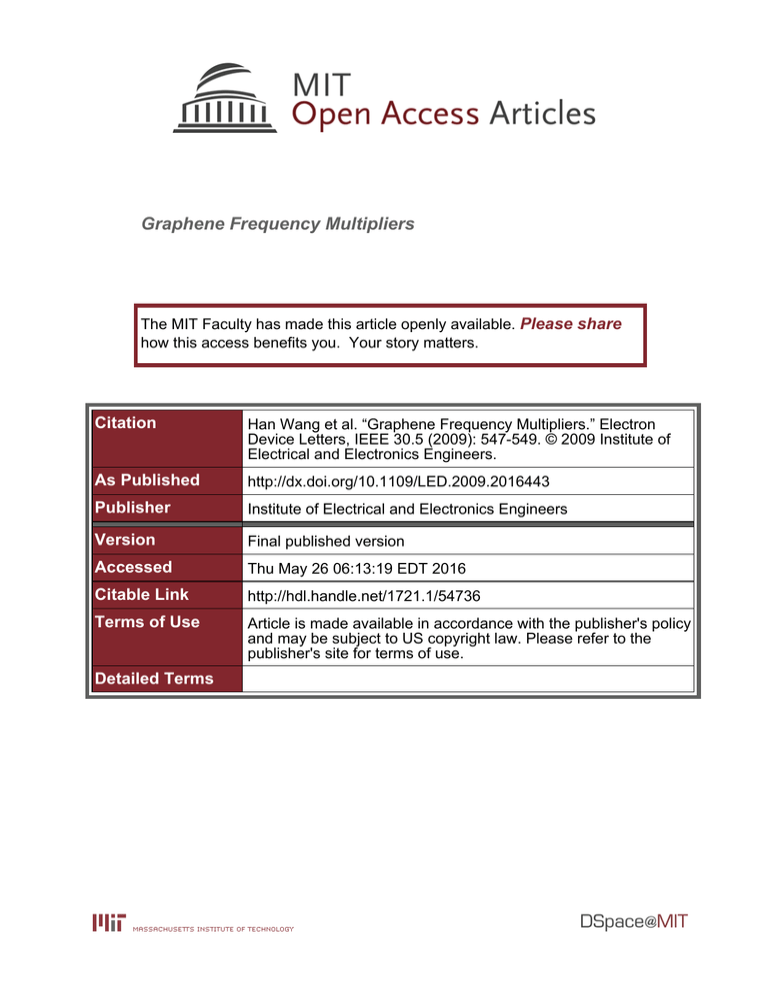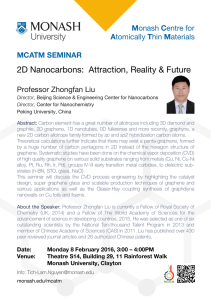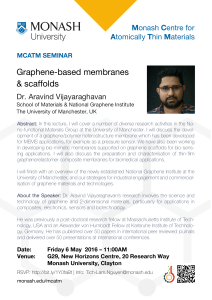Graphene Frequency Multipliers Please share
advertisement

Graphene Frequency Multipliers The MIT Faculty has made this article openly available. Please share how this access benefits you. Your story matters. Citation Han Wang et al. “Graphene Frequency Multipliers.” Electron Device Letters, IEEE 30.5 (2009): 547-549. © 2009 Institute of Electrical and Electronics Engineers. As Published http://dx.doi.org/10.1109/LED.2009.2016443 Publisher Institute of Electrical and Electronics Engineers Version Final published version Accessed Thu May 26 06:13:19 EDT 2016 Citable Link http://hdl.handle.net/1721.1/54736 Terms of Use Article is made available in accordance with the publisher's policy and may be subject to US copyright law. Please refer to the publisher's site for terms of use. Detailed Terms IEEE ELECTRON DEVICE LETTERS, VOL. 30, NO. 5, MAY 2009 547 Graphene Frequency Multipliers Han Wang, Daniel Nezich, Jing Kong, and Tomas Palacios, Member, IEEE Abstract—In this letter, the ambipolar transport properties of graphene flakes have been used to fabricate full-wave signal rectifiers and frequency-doubling devices. By correctly biasing an ambipolar graphene field-effect transistor in common-source configuration, a sinusoidal voltage applied to the transistor gate is rectified at the drain electrode. Using this concept, frequency multiplication of a 10-kHz input signal has been experimentally demonstrated. The spectral purity of the 20-kHz output signal is excellent, with more than 90% of the radio-frequency power in the 20-kHz frequency. This high efficiency, combined with the high electron mobility of graphene, makes graphene-based frequency multipliers a very promising option for signal generation at ultrahigh frequencies. Index Terms—Frequency doublers, frequency multipliers, fullwave rectifiers, graphene field-effect transistors (G-FETs). I. I NTRODUCTION F REQUENCY multiplication has always been an indispensable part of radio communication and broadcasting technology. It was recognized early on as a crucial signal generation technique, where a signal of frequency f0 is introduced to a nonlinear element to generate harmonics, and therefore power, at higher frequencies. For the last 60 years, diode and field-effect-transistor (FET)-based frequency multipliers have seen rapid progress. At present, the best Schottky diode frequency multipliers can generate signals with frequencies above 1 THz, being the only commercial option for signal generation at these frequencies [1]–[4]. Present applications of frequency multipliers span over all major areas of digital and analog communications, radio astronomy, and terahertz sensing. However, the intrinsic operating properties of existing frequency multipliers limit their future potential. Diode-based multipliers offer relatively high efficiencies (∼30%) but lack signal amplification [1], [2], [4]. FET-based multipliers offer signal gain at the cost of a very low efficiency (< 15%) [1], [3]. In both cases, the spectral purity of the generated signal is very poor, and additional components are often needed to filter the useful frequencies. In this letter, we demonstrate a new frequency-multiplier device based on the unique properties of graphene with the potential to overcome the main problems of conventional frequency multipliers. For the first time, frequency doubling is realized with just a single transistor device that can give very high spectral purity at the output without any additional filtering. Manuscript received September 28, 2008; revised February 17, 2009. First published March 31, 2009; current version published April 28, 2009. This work was supported in part by MIT/Army Institute for Soldier Nanotechnologies (ISN) and by the Interconnect Focus Center (SRC/FCRP IFC). The review of this letter was arranged by Editor X. Zhou. The authors are with the Microsystems Technology Laboratories, Massachusetts Institute of Technology, Cambridge, MA 02139 USA (e-mail: hanw@mtl.mit.edu). Digital Object Identifier 10.1109/LED.2009.2016443 Fig. 1. (a) Piecewise linear approximation of the transfer characteristic of ambipolar G-FETs. Vg,min , the minimum conduction point, is equal to the quiescent bias point for full-wave rectification and frequency doubling. (b) Graphene-based circuit for frequency multiplication of the input signal Vin . With the device being biased at the minimum conduction point, electrons (e− ) and holes (h+ ) conduct alternatively in neighboring half-cycles of the output signal. (c) Typical full-wave rectifier circuit. (d) Ideal input–output characteristics of a full-wave rectifier. II. F ULL -W AVE R ECTIFIERS AND F REQUENCY D OUBLERS B ASED ON A MBIPOLAR C ONDUCTION IN G RAPHENE Since its discovery in 2004, graphene has been attracting great interest for novel electronic devices [5]. Its extremely high electron and hole mobility (> 100 000 cm2 /V · s at room temperature) [6], in combination with its high critical electric field and thermal conductivity, makes this material an excellent candidate for many high-frequency electronic applications. Several groups have demonstrated the successful fabrication of graphene FETs (G-FETs) [7]–[11], which show great potential for radio-frequency (RF) and mixed-signal applications. However, the unique properties of graphene also allow for completely new devices, which are not possible in other materials, including nonlinear electronics for full-wave signal rectification and frequency multiplication. G-FETs are ambipolar devices [5], [8], [11], [12]. The drain current is based on hole conduction for gate-to-source voltages below the minimum conduction point voltage (Vg,min ), while at higher voltages, electron conduction dominates, as shown in Fig. 1(a). This “V”-shaped current–voltage (I–V ) characteristic 0741-3106/$25.00 © 2009 IEEE Authorized licensed use limited to: MIT Libraries. Downloaded on November 16, 2009 at 15:14 from IEEE Xplore. Restrictions apply. 548 IEEE ELECTRON DEVICE LETTERS, VOL. 30, NO. 5, MAY 2009 Fig. 2. Structure of the fabricated G-FET. (a) Optical micrograph showing single-layer graphene flakes. (b) Optical micrograph of the structure of the final device. The device is back gated through the p-type Si wafer. (c) Schematic of the vertical structure of the device. [8], [9], [12]–[15] closely resembles that of an ideal full-wave rectifier [16] [Fig. 1(c) and (d)]. If the gate of the G-FET is biased at the minimum conduction point and a sinusoidal signal of frequency f0 is superposed to the gate bias voltage [Fig. 1(b)], full-wave rectification can be obtained at the drain contact of the device, where the output drain current alternates between electron and hole transport. This new application of G-FETs allows full-wave rectification to be realized with a much simpler circuit and can hence significantly improve the simplicity of numerous communication systems based on amplitude modulation and RF technology, of which rectifiers are an integral part. Graphene devices with the structure shown in Fig. 1(b) can also be used as frequency multipliers where the output signal has a fundamental frequency double that of the input signal. These graphene frequency doublers offer an alternative approach to the existing complicated frequency-doubling circuit [17], [18]. III. E XPERIMENTAL R ESULTS To demonstrate these new applications, we have fabricated G-FET devices from exfoliated graphene flakes. One of the fabricated devices and its schematic structure are shown in Fig. 2(b) and (c). The graphene that comprises the device channel was deposited by standard mechanical exfoliation of HOPG graphite on top of 300 nm of thermal silicon dioxide with an underlying p-doped silicon wafer substrate that serves as a back gate for the final device. Inspection with an optical microscope confirms the successful exfoliation of single-layer graphene by means of optical interference contrast differences, which varies with the number of graphene layers [Fig. 2(a)]. A layer of poly(methyl methacrylate) (950 000 MW) was deposited and used as an e-beam resist for two exposures. The first e-beam lithography exposure created alignment marks, and the second exposure defined source and drain contacts to the graphene. After both lithographies, a 10-nm-Cr/70-nm-Au metal stack was deposited using a thermal evaporator. After liftoff in acetone, the device was rinsed in isopropanol and blown dry with nitrogen. The channel length of the fabricated device is 1.3 µm, and the mean width is 2.7 µm. The dc characteristics of the graphene devices, i.e., IDS –VGS and IDS –VDS , were measured with an HP4156A semiconductor parameter analyzer. In the characterization of the RF perfor- Fig. 3. Measured IDS –VGS transfer characteristics of the fabricated G-FET. The channel length of the device is 1.3 µm, and its mean width is 2.7 µm. mance, the graphene device was used in a common-source configuration [Fig. 1(b)], with a known series resistance (5.03 kΩ). The total drain bias was 2.87 V, and the voltage drop across the graphene device was monitored with an Agilent DSO3062 oscilloscope. The current through the graphene device was modulated by changing the back-gate voltage applied to the doped silicon substrate, which was provided by the added voltage of GW Instek PSP-603 (dc) and Agilent 33250A (ac) power supplies. The ambipolar character of graphene is responsible for the V-shaped transfer characteristic of the fabricated device, as shown in Fig. 3. The minimum conduction point (Vg,min ) is determined as the minimum point on the IDS –VGS characteristics (i.e., 20.1 V).This device was used in the circuit shown in Fig. 1(b), and a 10-kHz input signal was applied to the device gate. A gate bias voltage of 22.7 V was applied to bias the device slightly above the minimum conduction point so that the amplitudes of electron and hole conductions are symmetrical. From the waveforms measured for the input (dotted curve) and output (solid curve) signals (Fig. 4), clear frequency multiplication is observed in the output signal, where the fundamental frequency is 20 kHz. This frequency-doubler device shows high spectral purity in the output RF signal, where 94% of the output RF energy is at the fundamental frequency (20 kHz). Measurements at a lower input frequency (100 Hz) showed similar spectral purity, confirming that the high spectral purity at the output is due to the sublinear IDS –VGS characteristics, not to parasitic capacitances. This is the first time that frequency doubling is realized with just a single transistor device and gives such a high spectral purity at the output without any filtering elements. IV. D ISCUSSION AND C ONCLUSION The high RF conversion efficiency shown by the graphene frequency multiplier is due to the slightly sublinear I–V characteristics of the fabricated device near the minimum conduction point (Fig. 3), which shapes the output-signal waveforms to significantly reduce the power coupled to higher order harmonics. The sublinear characteristics of the graphene device near the minimum conduction point results from a combination of charged-impurity, ripple, and short-range scattering in graphene [19], [20]. Chen et al. [20] show that it is possible to engineer Authorized licensed use limited to: MIT Libraries. Downloaded on November 16, 2009 at 15:14 from IEEE Xplore. Restrictions apply. WANG et al.: GRAPHENE FREQUENCY MULTIPLIERS Fig. 4. (Dotted curve) Measured input and (solid curve) output of the frequency-multiplier circuit when the graphene device is biased near the minimum conduction point. For clarity of display, the output signal is multiplied by 50, and both signals are ac coupled. The low amplitude of the measured output signal is due to the poor on/off current ratio of the fabricated device, and it can be improved by using a G-FET with better transfer characteristics. the shape of the sublinear characteristics and the location of the minimum conduction point by controlled impurity (potassium) doping on graphene surface. Furthermore, the concept described in this letter can be also realized in other materials that exhibit ambipolar conduction properties, such as amorphous silicon [21], organic semiconductor heterostructures [22], organic single crystals [23], and some carbon nanotube transistors (CNTs) [24], [25], although graphene is the most suitable for high-frequency applications due to its very high mobility. CNTs have mobility that is comparable to that of graphene. However, the ambipolar Ids –Vgs characteristics of GFETs are often more linear than CNT FETs’ [25], leading to a higher spectral purity and efficiency. In summary, this letter demonstrates for the first time the use of the ambipolar transport properties of graphene in the fabrication of nonlinear electronics for full-wave rectification and frequency doubling of electrical signals. Although the measurement setup limited the input frequency to 10 kHz, these devices are expected to work at much higher frequencies due to the outstanding transport properties of graphene and the simplicity of the proposed circuit, which significantly reduce parasitic capacitances and resistances. With the rapid developments in the design and fabrication of G-FET and other ambipolar devices, we may soon see ambipolar FETs leading the next revolution in communications technology. ACKNOWLEDGMENT H. Wang and D. Nezich have contributed equally to this letter. R EFERENCES [1] M. T. Faber, J. Chramiec, and M. E. Adamski, Microwave and MillimeterWave Diode Frequency Multipliers. Norwood, MA: Artech House, 1995. [2] M. Golio, RF and Microwave Semiconductor Device Handbook. Boca Raton, FL: CRC Press, Oct. 2002. 549 [3] E. Camargo, Design of FET Frequency Multipliers and Harmonic Oscillators. Norwood, MA: Artech House, Jan. 1998. [4] J. Ward, E. Schlecht, G. Chattopadhyay, A. Maestrini, J. Gill, F. Maiwald, H. Javadi, and I. Mehdi, “Capability of THz sources based on Schottky diode frequency multiplier chains,” in Proc. IEEE Int. Microw. Symp. Dig., 2004, vol. 3, pp. 1587–1590. [5] K. S. Novoselov, A. K. Geim, S. V. Morozov, D. Jiang, Y. Zhang, S. V. Dubonos, I. V. Grigorieva, and A. A. Firsov, “Electric field effect in atomically thin carbon films,” Science, vol. 306, no. 5696, pp. 666–669, Oct. 2004. [6] K. I. Bolotin, K. J. Sikes, Z. Jiang, M. Klima, G. Fudenberg, J. Hone, P. Kim, and H. L. Stormer, “Ultrahigh electron mobility in suspended graphene,” Solid State Commun., vol. 146, no. 9/10, pp. 351–355, Jun. 2008. [7] X. Li, X. Wang, L. Zhang, S. Lee, and H. Dai, “Chemically derived, ultrasmooth graphene nanoribbon semiconductors,” Science, vol. 319, no. 5867, p. 1229, Feb. 2008. [8] J. Kedzierski, P. Hsu, P. Healey, P. W. Wyatt, C. L. Keast, M. Sprinkle, C. Berger, and W. A. de Heer, “Epitaxial graphene transistors on SiC substrates,” IEEE Trans. Electron Devices, vol. 55, no. 8, pp. 2078–2085, Aug. 2008. [9] X. Lou, Y. Lee, A. Konar, T. Fang, H. Xing, G. Snider, and D. Jena, “Current-carrying capacity of long and short channel 2D graphene transistors,” in Proc. 66th Device Res. Conf. Dig., Jun. 2008, pp. 29–30. [10] X. Wang, Y. Ouyang, X. Li, H. Wang, J. Guo, and H. Dai, “Roomtemperature all-semiconducting sub-10 nm graphene nanoribbon fieldeffect transistors,” Phys. Rev. Lett., vol. 100, no. 20, p. 206 803, May 2008. [11] J. Zhu and J. C. S. Woo, “A novel graphene channel field effect transistor with Schottky tunneling source and drain,” in Proc. 37th Eur. Solid State Device Res. Conf., Sep. 2007, pp. 243–246. [12] A. H. C. Neto, F. Guinea, N. M. R. Peres, K. S. Novoselov, and A. K. Geim, “The electronic properties of graphene,” Rev. Mod. Phys., vol. 81, no. 1, pp. 109–162, Jan.–Mar. 2009. [13] M. C. Lemme, T. J. Echtermeyer, M. Baus, and H. Kurz, “A graphene field-effect device,” IEEE Electron Device Lett., vol. 28, no. 4, pp. 282– 284, Apr. 2007. [14] Y. Lin, D. B. Farmer, G. S. Tulevski, S. Xu, R. G. Gordon, and P. Avouris, “Chemical doping of graphene nanoribbon field-effect devices,” in Proc. 66th Device Res. Conf. Dig., Jun. 2008, pp. 27–28. [15] Y. Ouyang, Y. Yoon, and J. Guo, “Scaling behaviors of graphene nanoribbon FETs: A three-dimensional quantum simulation study,” IEEE Trans. Electron Devices, vol. 54, no. 9, pp. 2223–2231, Sep. 2007. [16] S. Khucharoensin and V. Kasemsuwan, “A high performance CMOS current-mode precision full-wave rectifier (PFWR),” in Proc. Int. Symp. Circuits Syst., vol. 1, pp. I-41–I-44. [17] A. Nedungadi, “Accurate translinear sinusoidal frequency doubler,” Electron. Lett., vol. 15, no. 8, pp. 228–229, Apr. 1979. [18] V. Puyal, A. Konczykowska, P. Nouet, S. Bernard, M. Riet, M. Jorge, and J. Godin, “A broad-band active frequency doubler operating up to 120 GHz,” in Proc. Eur. Microw. Conf., 2005, vol. 3, pp. 557–560. [19] S. Adam, E. H. Hwang, V. M. Galitski, and S. Das Sarma, “A selfconsistent theory for graphene transport,” Proc. Nat. Acad. Sci. USA, vol. 104, no. 47, pp. 18 392–18 397, Nov. 2007. [20] J. Chen, C. Jang, S. Adam, M. S. Fuhrer, E. D. Williams, and M. Ishigami, “Charged-impurity scattering in graphene,” Nat. Phys., vol. 4, no. 5, pp. 377–381, May 2008. [21] G. W. Neudeck, H. F. Bare, and K. Y. Chung, “Modeling of ambipolar a-Si:H thin-film transistors,” IEEE Trans. Electron Devices, vol. ED-34, no. 2, pp. 344–350, Feb. 1987. [22] A. Dodabalapur, H. E. Katz, L. Torsi, and R. C. Haddon, “Organic heterostructure field-effect transistors,” Science, vol. 269, no. 5230, pp. 1560–1562, Sep. 1995. [23] J. H. Schön, S. Berg, C. Kloc, and B. Batlogg, “Ambipolar pentacene fieldeffect transistors and inverters,” Science, vol. 287, no. 5455, pp. 1022– 1023, Feb. 2000. [24] R. Martel, V. Derycke, C. Lavoie, J. Appenzeller, K. K. Chan, J. Tersoff, and P. Avouris, “Ambipolar electrical transport in semiconducting singlewall carbon nanotubes,” Phys. Rev. Lett., vol. 87, no. 25, p. 256 805, Dec. 2001. [25] J. Guo, S. Datta, and M. Lundstrom, “A numerical study of scaling issues for Schottky-barrier carbon nanotube transistors,” IEEE Trans. Electron Devices, vol. 51, no. 2, pp. 172–177, Feb. 2004. Authorized licensed use limited to: MIT Libraries. Downloaded on November 16, 2009 at 15:14 from IEEE Xplore. Restrictions apply.





